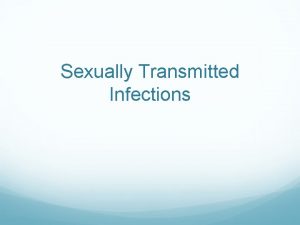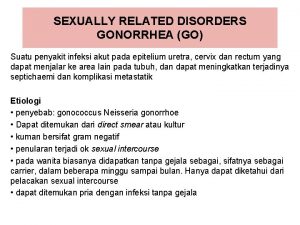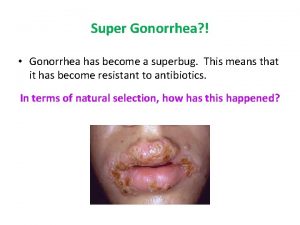Gonorrhea Dasha Kaylin and Zaine History of the









- Slides: 9

Gonorrhea Dasha, Kaylin and Zaine

History of the Disease- its effect on society • Gonorrhea(the clap) is a sexually transmitted infection that dates back to the medieval times • The earliest record of the disease was at the 1600’s • This caused a widespread of the infection causing the English parliament to enact a law to prevent the spread • The clap: gonorrhea was originally referred to as the clap The nickname came about because the infected person would report feeling a clapping sensation while urinating. • Others say the nickname came from French brothels called “ Les Clapiers”. Men who visited these brothels ended up infected • Gonorrhea is transmitted through sexual contact with an infected partner • It can also be spread perinatally from • mother to baby during childbirth 2 1/6/2022 Add a footer

Symptoms, time course and the results of the disease • When symptoms do occur, they might only appear 2 -7 days after infection. Female: • • Increased vaginal discharge • Pain in the abdomen or in the lower back • Vaginal bleeding after intercourse or between menstrual periods • Pain during intercourse • Both female and male: • Painful urination • Pain, itching, bleeding, and/or mucus discharge of the rectum • The results of the disease is that woman become infertile and very rarely men can become infertile. • 1% die from gonorrhea and you are not left disabled but you just can’t have kids • males • Redness, itching, and/or discharges of the eyes (for gonorrhea in the eyes) • Throat infection • Male: • Thick, yellowish-green discharge from penis • Testicular pain or swelling • Itching penis 3 1/6/2022 Add a footer

Means of transmission and affected populations? • People who have gonorrhea and have received treatments may be re-infected if they engage sexually with an infected partner. • Any sexually active person can get infected. In the US, the highest reported rates of infections are among sexually active teenagers and young adults • There an estimated 78 million new cases of gonorrhea • It is easily treated but can cause serious and permanent complications. • Pelvic inflammatory disease occurs in women when the gonorrhea infection affects the uterus or fallopian tubes • Most serious complications lead to infertility • In men , complications like epididymitis rise ( an inflammation of the tube which carries the sperm ) can also cause infertility • Symptoms in men : • Burning sensation while urinating • Greater Frequency or urgency of urination • Pus like discharge from the penis • Swelling or pain in testicles • 4 1/6/2022 Add a footer

Detection, prevention and treatment • Detection • You will detect it and notice it in 2 -7 days an you can feel symptoms or you can go get tested by your doctor. • Prevention • Condoms can help prevent the spread of gonorrhea during anal or vaginal sex, and condoms or dental dams can be used for protection during oral sex. • Testing: By swabbing the infected area or a urine sample • Treatment: • Anyone treated for gonorrhea should be re-tested 6 months afterwards. • Patients treated for gonorrhea should also be treated for chlamydia. • Don’t have sex until treatment is complete (7 days after antibiotics). • Dual therapy which is when you use two drugs instead of one • Complications • If left untreated, gonorrhea can cause serious health complications. • In women, untreated gonorrhea can lead to pelvic inflammatory disease (PID). PID health risks include abdominal pain, fever, internal abscesses, long-lasting pelvic pain, and scarring of the fallopian tubes causing infertility and increasing the chance of ectopic or tubal pregnancies. • With the right course of treatment you will get better and if you follow the doctors checkups 5 1/6/2022 Add a footer

Description of the Disease Organism The scientific name of the Gonorrhea bacteria is Neisseria gonorrhoeae The disease is almost always transmitted through sexual contact If left untreated, Gonorrhea can have serious consequences on health In men the infection usually starts at the urethra, near the tip of the penis. In women the infection starts at the cervix. When women are infected, the bacteria can move to the fallopian tubes, rendering them infertile. A woman with Gonorrhea can infect an infant and the bacteria can infect the infant’s eyes through contact with the infected cervix during childbirth. The bacteria can also infect the mucous membranes of the throat, mouth, eyes, and rectum. 6 1/6/2022 Add a footer

This Disease in the Future Gonorrhea is quickly becoming a Super Bug and is rapidly developing an increased resistance to drugs. Gonorrhea is becoming more largely antibiotic resistant, There is only one type of antibiotic that is largely affective that remains Throughout the 2000 s the CDC steadily eliminated certain antibiotics as effective treatments. Now, the CDC recommends dual therapy to try and combat antibiotic resistance CDC’s STD Treatment Guidelines recommend one regimen of dual therapy for the treatment of gonorrhea. Antibiotic resistance continues to be monitored nationally. Information is from the Center of Disease Control is the United States 7 1/6/2022 Add a footer

Part 2 Laboratory Challenges Culture testing is when bacteria is first grown on a nutrient plate and is then exposed to known amounts of an antibiotic to determine the bacteria’s susceptibility to the antibiotic. Less labs are doing culture testing due to the emergence of new technology. Currently there is no technology that can do reliable antibiotic susceptibility testing from nonculture specimens. New technology is expected to be developed to help monitor antibiotic resistance It is harder to monitor susceptibility because of the lessening amounts of culture testing Gonorrhea is a very common infectious disease. Approximately 820, 000 new gonococcal infections occur in the United States each year. That number is estimated to increase 8 1/6/2022 Add a footer

Bibliography CDC. (2017, September 26). CDC Detailed Gonorrhea Fact Sheet. Retrieved from CDC: https: //www. cdc. gov/std/gonorrhea/stdfact-gonorrhea-detailed. htm CDC. (2018, April 6). Antibiotic-Resistant Gonorrhea. Retrieved from Center for Disease Control and Prevention: https: //www. cdc. gov/std/gonorrhea/arg/default. htm World Book Online. (n. d. ). Gonorrhea. Retrieved from World Book Online: https: //worldbookonline. com/advanced/article? id=ar 229100&st=gonorrhea#tab=homepage "Gonorrhea. " UXL Science, UXL, 2008. Science In Context, http: //link. galegroup. com/apps/doc/CV 2646000503/SCIC? u=43 riss&sid=SCIC&xid=e 8 cda 798. Accessed 9 Apr. 2018. The provided class website http: //www. sexualityandu. ca/ 9 1/6/2022 Add a footer

















